Mitigation and Remedy of Groundwater Arsenic Menace in India
Mitigation and Remedy of Groundwater Arsenic Menace in India
Mitigation and Remedy of Groundwater Arsenic Menace in India
Create successful ePaper yourself
Turn your PDF publications into a flip-book with our unique Google optimized e-Paper software.
A Critical Appraisal- Future Risk, Scope to Remediate, Technological Competence, etc.the latter is be<strong>in</strong>g displaced dur<strong>in</strong>g <strong>in</strong>jection. The essence <strong>of</strong> <strong>in</strong> situ treatment is, <strong>in</strong> fact, the ironremoval, <strong>and</strong> hence, arsenic removal, it cont<strong>in</strong>ues even after the complete withdrawal <strong>of</strong> the<strong>in</strong>jected water. The result<strong>in</strong>g ferric iron is highly <strong>in</strong>soluble <strong>and</strong> precipitates as an oxyhydroxide. Ithas been found that clogg<strong>in</strong>g does not occur, even <strong>in</strong> the case <strong>of</strong> systems, operat<strong>in</strong>g for morethan 30 years. The lack <strong>of</strong> clogg<strong>in</strong>g suggests that precipitation takes place at a distance awayfrom the well <strong>and</strong> possibly at vary<strong>in</strong>g locations <strong>in</strong> time.In the aquifer, the fronts spread out due to dispersion <strong>and</strong> the comb<strong>in</strong>ed effects <strong>of</strong>transport <strong>and</strong> reaction. When a new run is started with the <strong>in</strong>jection <strong>of</strong> oxygenated water, theconcentration <strong>of</strong> iron <strong>in</strong>creases gradually <strong>in</strong> the well on pump<strong>in</strong>g, <strong>and</strong> its efficiency depends onthe limit<strong>in</strong>g concentration <strong>of</strong> Fe 2 . With each cycle 1000 cubic meter <strong>of</strong> oxygenated water may be<strong>in</strong>jected <strong>and</strong> 7000 cubic meter pumped out. The ensu<strong>in</strong>g runs show a delayed rise <strong>of</strong> ironconcentration, <strong>in</strong> the pumped water. In other words, the efficiency <strong>in</strong>creases with the number <strong>of</strong>runs. The efficiency can better be improved, by optimiz<strong>in</strong>g the well arrangement, for example, by<strong>in</strong>stall<strong>in</strong>g separate <strong>in</strong>jection <strong>and</strong> pump<strong>in</strong>g wells, to prevent the last part <strong>of</strong> oxygenated water,be<strong>in</strong>g withdrawn without reaction.<strong>Groundwater</strong> pH should be above 6 for <strong>in</strong> situ iron removal, because rapid decrease <strong>of</strong>oxidation rate <strong>of</strong> Fe 2 occurs when pH is below 6. Moreover, if the aquifer conta<strong>in</strong>s lot <strong>of</strong> sulphides,the oxidation acidifies the system. And aquifers should be as homogeneous as possible. And thisshould be without extremely coarse layers to prevent preferential flow <strong>of</strong> <strong>in</strong>jected water, throughthe most permeable parts, which generally have low exchange capacity. Thus, plann<strong>in</strong>g for <strong>in</strong>situ remediation, with <strong>in</strong>jection <strong>of</strong> oxygenated water (pH ~7.5), four times a year, is a plausiblelong last<strong>in</strong>g mitigation technique for decontam<strong>in</strong>ation <strong>of</strong> arsenic <strong>in</strong> groundwater.Researchers <strong>in</strong> the Queens University, Belfast, claimed to have developed a low-costtechnology, which <strong>of</strong>fers chemical-free groundwater arsenic treatment technology to providearsenic-free water to rural communities for dr<strong>in</strong>k<strong>in</strong>g <strong>and</strong> farm<strong>in</strong>g needs. The technology is basedon recharg<strong>in</strong>g a part <strong>of</strong> the groundwater, after aeration, <strong>in</strong>to a subterranean aquifer (permeablerock), which is able to hold water. Increased levels <strong>of</strong> oxygen, <strong>in</strong> the groundwater, slow down thearsenic release from the soil. At higher dissolved oxygen levels, soil micro organisms as well asiron <strong>and</strong> manganese reduce the dissolved arsenic level significantly. Based on this concept, a trialplant <strong>in</strong> Kasimpore near Kolkata was planted <strong>and</strong> its performance was found satisfactory.6.3.2 Limestone-based <strong>Arsenic</strong> Removal MethodsExperiments have been performed, us<strong>in</strong>g Limestone to remove arsenic from water. Thisapproach is supported by previous research, regard<strong>in</strong>g the removal <strong>of</strong> arsenic by the formation<strong>of</strong> calcium arsenate (Bothe <strong>and</strong> Brown, 1999). Mobilization <strong>of</strong> arsenic, from sediment, is mostlikely when the sediment is low <strong>in</strong> iron <strong>and</strong> calcium carbonate (Brannon <strong>and</strong> Patrick, 1987). Areasonable conclusion is that arsenic is immobilized <strong>in</strong> iron <strong>and</strong>/or calcium compounds. Work on116NIH & CGWB




